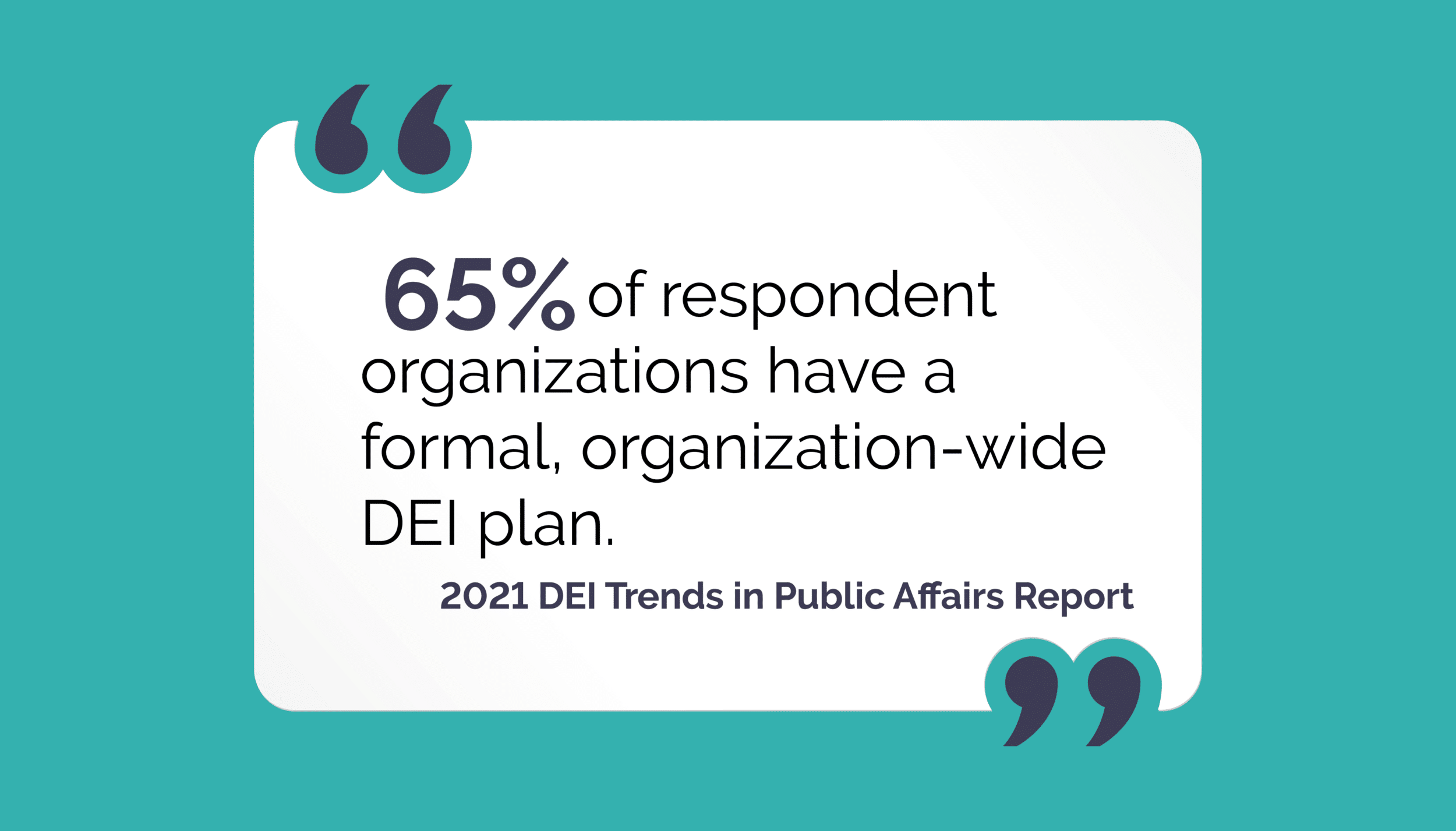Survey: People of Color Represent only 17% of Public Affairs Profession
Study respondents say low diversity discourages people from pursuing careers in field
Washington, D.C. – A new survey by the Public Affairs Council on diversity, equity and inclusion (DEI) finds the average share of public affairs staff who are people of color is just 17%, significantly lower than the actual racial diversity of the U.S. (approximately 40%, according to the U.S. Census).
The survey of 127 public affairs executives, conducted between Feb. 9 and March 5, 2021, also examines DEI policies and practices in strategy and governance; hiring, staffing and training; working with external groups; and advancement and programming.
The survey is among the first deliverables of the Public Affairs Council’s DEI initiative, which was recently launched to grow diversity in the profession and in senior-level positions, engage a more diverse base of experts in education programs, and eliminate racial inequities in public affairs.
Diversity was measured in two ways: actual diversity (the percentage of function staff who are people of color) and perceived relative diversity (how the respondent perceives the diversity of his/her function compared with the profession as a whole). The findings show that these two measurements are aligned. Respondents who view their public affairs function as lacking representation do in fact have low diversity, and there were similar correlations for those who perceive their functions as having average or high diversity.
“Respondents are viewing their team’s diversity as it actually is, rather than as they think it should or could be,” says Public Affairs Council President Doug Pinkham. “This honest assessment will help us set a path to progress as we work to fulfill the objectives of our DEI initiative.”
Other key findings from the survey include:
Lack of diversity seen as a barrier to entry
- 61% of respondents say lack of diversity discourages individuals from entering the field.
- 40% rated their team as having below-average diversity compared with the field. Only 23% rated their team as having above-average diversity.
- Despite current concerns about low diversity, 83% believe diversity and inclusion in the profession will increase in the next three to five years.
- Although nearly two-thirds of respondent organizations have a DEI plan, only one-third (35%) have a process in place to support the advancement of people of color to senior-level positions. Twenty percent have a formal process and 15% have an informal process.
Most organizations incorporate DEI into their strategic plans and staffing
- Most respondents (65%) have a formal, organization-wide DEI plan, with corporations outpacing associations 77% to 48%.
- A majority (59%) build DEI goals into their broader strategic plans on an organization-wide basis. An additional 10% do so in strategic plans for specific departments or other teams.
- A majority (57%) have one or more staff members primarily focused on DEI. An additional 26% have staff with DEI responsibilities as part of their job description.
- DEI training for staff is common, with 77% of respondents stating that their organization offers DEI training for all or some employees.
Associations and charitable nonprofits are top groups to partner with on DEI
- Half (50%) of respondent organizations have partnered with other groups to advance DEI, and 20% are considering partnering.
- Of those that have partnered with other groups, 46% have partnered with trade associations/ professional societies. Charitable/community nonprofits also led the list of preferred partner groups at 46%.
- The public affairs function has a primary role in 29% of DEI partnerships.
DEI programs strengthen stakeholder relationships and improve employee morale
- For respondents who identified specific benefits to their organization, top benefits were improved cultural understanding (79%), improved employee morale (76%), better overall reputation of the organization (48%) and improved external relations (44%).
- For respondents who identified specific benefits to their function, top benefits were greater cultural sensitivity when advocating on difficult issues (77%), stronger relationships with stakeholders/potential allies (63%), improved employee morale (51%), better relationships with elected officials (40%) and stronger employee support for political engagement (40%).
“This survey gives us an important baseline from which to develop programs and initiatives to advance the profession and address diversity and social progress priorities,” says Roi Ewell, principal of Ewell & Associates and chair of the Council’s DEI Steering Committee.
This project was conducted through the Council’s research affiliate, the Foundation for Public Affairs.
View the survey findings here.
About the Public Affairs Council
Both nonpartisan and nonpolitical, the Public Affairs Council is the leading association for public affairs professionals worldwide. The Council’s mission is to advance the field of public affairs and to provide its 700 member companies, nonprofits and universities with the executive education and expertise they need to succeed while maintaining the highest ethical standards. Learn more about the Council at pac.org.
About the Foundation for Public Affairs
The Foundation for Public Affairs invests in the future of the profession through workforce development initiatives focused on diversity and inclusion, and by conducting research on emerging issues and trends.

More News & Resources
Whether you’re building cutting-edge campaigns, engaging communities on social, mobilizing advocates, or exploring the power of new AI tools, THIS is where the future of advocacy comes alive.


